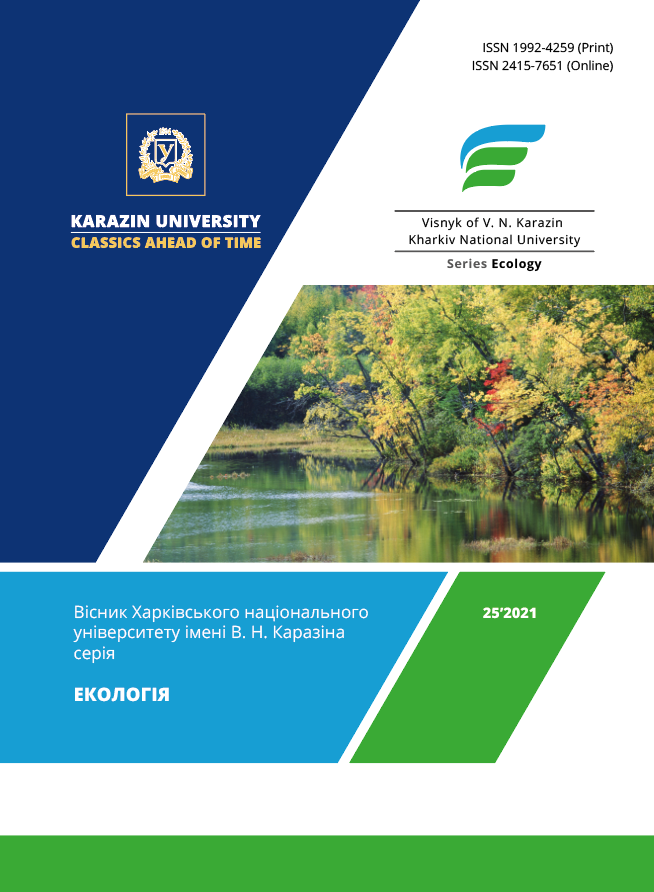Environmental Assessment of Surface Water Body Quality (on the Example of the Psel River)
Abstract
Purpose. To analyze the qualitative malt of the surface water body to determine changes in its ecological status.
Methods. Statistical and systematic analysis of ecological status changes was performed according to the interactive map "Monitoring and ecological assessment of water resources of Ukraine" of the river Psel for 2012 - 2020 on the following indicators: nitrates, nitrites, phosphates, ammonium ions, sulfates, chlorides.
Results. It was found that in the Psel River in 2019 there was a decrease in the total phosphate content from point Nr 1 to point Nr 6. At the same time, there is a significant increase near Bishkin village. The reason may be the placement of a fence post in a settlement where there are no treatment facilities. There is an increase in nitrate concentration, while in the Kaminne village and Velyka Bagachka urban-type settlement there is a decrease in nitrate concentrations, which may be associated with their consumption of phytoplankton, which should lead to increased turbidity and biological oxygen demand. The increased concentration of nitrites indicates the intensity of decomposition of organic matter, and the delay of oxidation of NO2– to NO3–, which clearly indicates the pollution of the reservoir. Nitrates and nitrites enter the water from the effluents of industrial and agricultural enterprises. The decrease in the ammonium ions concentration (the Chervone village) is most likely due to their oxidation, dissolved in water by oxygen, with the formation of nitrate ions. There is an increase in chloride content. The increase in chloride concentration near the Byshkin village and the Kaminne village is due to the pollution of surface water bodies with domestic wastewater. There is an increase in the sulfates content. For the manufacture of fertilizers or chemicals in the technological process at the enterprise sulfuric acid is used. Therefore, it can be assumed that the discharges of untreated water by the enterprise can be the reason for the increase in the content of sulfates in the river water.
Conclusions. An analysis of changes in the ecological status of the Psel River on the basis of data «Monitoring and environmental assessment of water resources of Ukraine» for 2012 – 2020 was performed. It is revealed that the river Psel is under rgular technogenic impact, has a tendency to steady deterioration of its ecological condition.
Downloads
References
Ponomarenko, R. V. (2020). Scientific and theoretical bases of reduction of technogenic loading on systems of water supply of region taking into account the basic principles of basin management of water resources: monograph, Kharkiv, Publ. Planet-Print Retrieved from http://repositsc.nuczu.edu.ua/handle/123456789/10628. (in Ukrainian)
Ponomarenko, R., Plyatsuk, L., Hurets, L., Polkovnychenko, D., Grigorenko, N., Sherstiuk, M., & Mi-akaiev, O. (2020). Determining the effect of anthropogenic loading on the environmental state of a surface source of water supply. Eastern-European Journal of Enterprise Technologies, 3/10 (105), 54–62. https://doi.org/10.15587/1729-4061.2020.206125
On approval of the Procedure for state water monitoring: Post of the Cabinet of Ministers of Ukraine of September 19, 2018 No 758. Retrieved from https://zakon.rada.gov.ua/laws/show/758-2018-%D0%BF#Text (in Ukrainian)
Jianga, J., Tangab, S., Hanc, D., Fud, G., Solomatinee, D., Zheng, Y. (2020). A comprehensive review on the design and optimization of surface water quality monitoring networks. Environmental Modelling & Software, 132, 104792. https://doi.org/10.1016/j.envsoft.2020.104792
Ho K,T., Konovets, I.M., Terletskaya, A.V., Milyukin, M.V.…& Burgessm R.M. (2020). Contaminants, mutagenicity and toxicity in the surface waters of Kyiv, Ukraine. Marine Pollution Bulletin, 155(June), 111153. https://doi.org/10.1016/j.marpolbul.2020.111153
Tretyakov, O., Bezsonnyi, V., Ponomarenko, R., & Borodich, P. (2019). Improving the efficiency of forecasting the impact of man-made pollution on surface water bodies. Problems of emergencies, 1(29), 61-78. https://doi.org/10.5281/zenodo.2602648 (in Ukrainian)
Ponomarenko, R., Plyatsuk, L., Kovalev, P., & Zat’ko, J. (2020). Study of changes in the quality of the surface water body under man-made conditions. Technogenic and ecological safety, 8(2/2020), 48–54. https://doi.org/10.5281/zenodo.4300769 (in Ukrainian)
Ponomarenko, R., Plyatsuk, L., Tretyakov, O., & Kovalev, P. (2019). Determination of the ecological state of the main source of water supply of Ukraine. Technogenic and ecological safety, 6(2/2019), 69–77. https://doi.org/10.5281/zenodo.3559035. (in Ukrainian)
State Agency of Water Resources of Ukraine. State Water Agency official website. URL: https://www.davr.gov.ua/ (in Ukrainian)
Ponomarenko, R., Kovalenko, S. (2021). Study of Changes in the Ecological Condition of the Psel River. Climate change and sustainable development: new challenges of the century: monograph, Mykolaiv, Rzeszow.
Clean water. (2020). Interactive map of river pollution in Ukraine. Retrieved from https://texty.org.ua/water (in Ukrainian)
Vigiak, O., Udias, A., Pistocchi, A., Zanni, M., Aloe, A., & Grizzetti, B. (2021). Probability maps of anthropogenic impacts affecting ecological status in European rivers. Ecological Indicators, Volume 126, 107684. https://doi.org/10.1016/j.ecolind.2021.107684
Kotkova, T. N., Fedjuchka, N. I., & Karas, I. F. (2018). Environmental assessment of drinking water in Luhyny district of Zhytomyr region on chlorides, sulphates and nitrates content. Scientific Bulletin of UNFU, 28(7), 83–87. https://doi.org/10.15421/40280718 (in Ukrainian).
Rules for accepting wastewater into centralized drainage systems.(2017). Approved By order of the Ministry of Regional Development development, construction and housing and communal services of Ukraine from 01.12.2017 No 316. Retrieved from https://zakon.rada.gov.ua/laws/show/z0056-18#Text (in Ukrainian).
Authors who publish with this journal agree to the following terms:
- Authors retain copyright and grant the journal right of first publication of this work under the terms of a license Creative Commons Attribution License 4.0 International (CC BY 4.0).
- Authors are able to enter into separate, additional contractual arrangements for the non-exclusive distribution of the journal's published version of the work (e.g., post it to an institutional repository or publish it in a book), with an acknowledgement of its initial publication in this journal.
- Authors are permitted and encouraged to post their work online (e.g., in institutional repositories or on their website) prior to and during the submission process, as it can lead to productive exchanges, as well as earlier and greater citation of published work.





